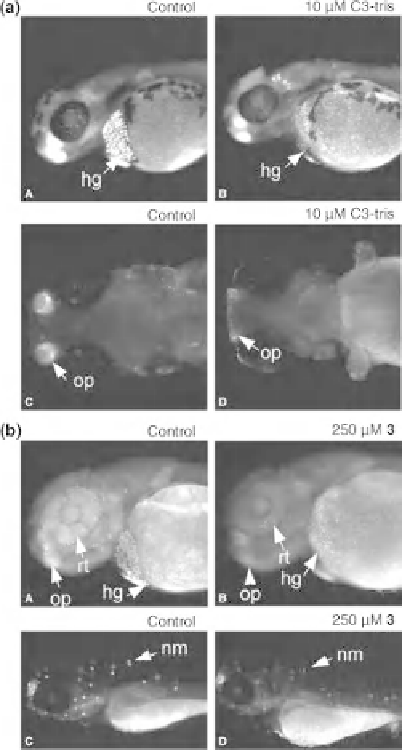Biomedical Engineering Reference
In-Depth Information
Figure 19.8
Inhibition of normal
apoptosis by 3 and C3-tris in zebrafish
embryos. (a) Decreased apoptosis after
C3-tris treatment. Compared to controls
(A and C), 10 mMC3-tris caused decreased
apoptosis in the hatching gland (hg) at 2dpf
(B) and olfactory pits (op) at 4dpf (D).
(b) Decreased apoptosis after treatment
with 3. Compared to controls (A and C),
decreased apoptosis in the hatching gland
(hg), olfactory pits (op), and retina (rt) was
observed at 2dpf (B). Decreased apoptosis
in neuromasts (nm) was observed at
5dpf (D).
of hearing acuity or deafness, respectively. The mechanism by which cisplatinum
induces cell death is believed to be primarily direct DNA damage, although
perturbation of cellular redox pathways may also play a role (Schweitzer, 1993).
In zebrafish embryos, cisplatinum rapidly induces apoptotic cell death in all of the
dorsal mechanoreceptor hair cells detectable by DASPEI staining. We assessed the
comparative ability of our water-soluble fullerenes to block cisplatinum-induced
mechanoreceptor cell apoptosis in zebrafish embryos. The results, displayed in
Fig. 19.9, indicate an unexpectedly wide variation among various anionic fullerenes.
Fullerene 3 displayed the highest efficacy, blocking 50% of cisplatinum-induced
apoptosis at low concentrations (29
m
M), followed by 4 (194
m
M), 7 (285
m
M), and 5
(438
M). C3 (1), though highly effective against the superoxide assay (Table 19.1),
was almost completely unable to block apoptosis induced by cisplatinum, achieving
only 5% protection at 500
m
m
M.

Search WWH ::

Custom Search